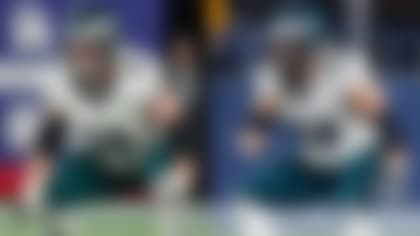After spending all summer analyzing teams, player situations, and tracking news to get prepared for the 2019 season -- it's time to get down to the fun stuff. To get you prepared to draft your squads this season, my fantasy team previews discuss every fantasy-relevant skill position player, positional strategy, and where I have players ranked versus their NFL.com average draft position (ADP). Let's get to it!
Atlanta Falcons
Quarterback: The Falcons have one of the most straight-forward teams to project in fantasy football. Matt Ryan has finished as a top-15 fantasy QB in eight of his past 9 seasons, 6 of which were top-8 performances. Ryan was simply stellar again last season, and he was far from the reason Atlanta regressed to a 7-9 record. Ryan dominated in all of the most important passing efficiency categories in 2018, finishing with top-5 marks in QB Rating when kept clean, under pressure, on using play-action passes, and when he threw deep per PFF. Last year's performance was all the more impressive considering Ryan played behind inconsistent protection that allowed 42 sacks (second-most of his career) and pressure on 31 percent of his dropbacks (seventh-highest rate in the NFL). To remedy their pass pro woes, Atlanta used two first round picks on G Chris Lindstrom and T Kaleb McGary. In free agency, Atlanta signed vet James Carpenter to play LG. Including C Alex Mack and LT Jake Matthews, the Falcons entire starting OL comprises of five former first rounders. There is no reason to reach on Ryan early in your league because of how deep quarterback is in fantasy, but Atlanta's offense feels weirdly underrated this season.
-- Ryan (Rk: QB5 vs. ADP: QB7)
Running Back: Devonta Freeman is one of the most deeply discounted RBs in fantasy after a slew of injuries ruined his 2018 season. Freeman hurt his knee in Atlanta's Week 1 opener -- causing him to miss a month of games -- before foot and groin issues ended his season a few weeks later. However, Tevin Coleman's departure in free agency opens up a true workhorse role for Freeman. Coleman saw 10.5 touches per game and played on 37 percent of snaps in his three full seasons playing with Freeman, which could potentially leave Freeman with a career-high workload in 2019. Freeman started eight games without Coleman in 2015-17, and he produced monster results with 24.7 PPR points, 121.3 scrimmage yards, and 22.6 touches per game. Freeman finished as a RB1 (top-12 scorer) in all but one game without Coleman in this span. Freeman's projected volume has never been higher and he's running behind the best line of his career, yet because of his injury history, his ADP remains tame at 35 overall. Ito Smith and fifth-rounder Qadree Ollison are the likely rotation behind Freeman this season. Smith averaged an inefficient 3.5 YPC and woeful 5.6 yards per reception on his 117 rookie touches, but he's the favorite to spell Freeman.
*-- Freeman (Rk: RB14 vs. ADP: RB17); Smith (Rk: RB59 vs. ADP: RB53) *
Wide Receiver: After former OC Steve Sarkisian maddeningly refused to feature Julio Jones in the red-zone, the Falcons knew a change was needed by mid-season. Entering their Week 8 bye, Julio still had not scored a touchdown -- extending his regular-season scoreless drought to a mind-bending 13 games. After seeing zero red-zone looks in Weeks 2-7, the Falcons made getting Julio the rock in scoring position a priority down the stretch. In Atlanta's final nine games last year out of their Week 8 bye, Julio saw at least one red-zone target in 7-of-9 contests while his 14 total red-zone looks trailed only Travis Kelce (15) in this span. Julio has logged WR2, WR5, WR2, WR6, WR10, and WR4 fantasy finishes in PPR points per game over the past six seasons and enters 2019 with the WR1 upside if Dirk Koetter continues feeding him in the red-zone. After leading all rookies in catches, yards, and TDs last year, Calvin Ridley is a no-brainer breakout candidate in the fifth round of fantasy drafts. Playing opposite of Julio Jones certainly has its advantages, and none are more clear than the defensive attention Julio dictates. Last year, Ridley faced press coverage off of the line of scrimmage on just 19 percent of his routes per Next Gen Stats, compared to 32 percent for Julio Jones. As one of the most technically sound route runners in the league, Ridley getting free releases off of the line scrimmage opposite Jones will prove to be a difficult task for any opposing defense to defend. Mohamed Sanu will continue to man the slot for Atlanta, but he is on the fantasy fringe in the late-rounds. Sanu is always a fine pick up off of the waiver wire if you're in a bye-week pinch, but he likely won't see enough weekly volume to sustain a consistently bankable role behind Jones, Freeman, and Ridley.
*-- Jones (Rk: WR6 vs. ADP: WR4); Ridley (Rk: WR24 vs. ADP: WR25) *
Tight End: We want pieces of this Falcons offense in fantasy, but Austin Hooper may not be the best player to target. Hooper's 2018 season (71/660/4) looks solid on the surface, but 40 percent of his 71 receptions came in just three games against the Steelers (9 receptions), Buccaneers (9), and Browns (10). Over the full season, Hooper saw just 14 percent of Falcons' targets in a year where Freeman essentially did not play and Calvin Ridley was a rookie. Now that Freeman is back and Ridley is firmly on the Year Two Breakout radar, Hooper looks a bit pricey relative to other late-round TEs like Mark Andrews, Delanie Walker, and Jordan Reed.
-- Hooper (Rk: TE16 vs. ADP: TE11)
Carolina Panthers
Quarterback: Fully healthy and cleared to practice after offseason shoulder surgery, few fantasy quarterbacks offer as much upside as Cam Newton does in 2019. After shedding Kelvin Benjamin in 2017 and letting Devin Funchess walk in 2018, Carolina has finally surrounded Newton with quick, explosive pass catchers that can create separation all over the field and add yards after the catch. Christian McCaffrey, D.J. Moore, Curtis Samuel, and veteran Greg Olsen form the most talented group of weapons that Newton has ever played with, but Newton's 2019 fantasy hype remains tame. That is a mistake. Newton has finished as the QB8 or better in fantasy points per game in 7-of-8 career seasons -- which includes five top-5 finishes -- and he was on pace for another top-5 performance before losing strength in his shoulder mid-season. In his first year playing with OC Norv Turner, Newton was playing at a career-high level prior to his injury. Cam completed 70 percent of his attempts and earned a magnificent 103.5 passer rating in Weeks 1-11 before falling apart in the Panthers final three games. Newton was miles improved from his career norm in completions (59 percent) and QB rating (83.5) because Turner cut Newton's attempts deep downfield significantly, instead opting for more short passes aimed at their shifty receivers. While Moore was a 21-year-old rookie and Samuel was just getting his feet wet last year, the Panthers passing offense has the potential to explode in 2019 as Carolina's receiver tandem matures.
-- Newton (Rk: QB8 vs. ADP: QB9)
Running Back: Carolina also fixed their run game in 2018 by installing Christian McCaffrey as the modern-day version of LaDainian Tomlinson. McCaffrey played on a mind-bending 962 snaps in 2018, the second-most for any running back in a single-season over the past decade. McCaffrey proved all of his doubters wrong after a somewhat inefficient rookie season on the ground by ripping off 5.0 YPC and tying Melvin Gordon for the league's seventh-best rushing success rate (56 percent) according to Next Gen Stats. McCaffrey was the league's most effective RB on first-and-ten according to Warren Sharp's metrics, too, earning 5.7 YPC and 53 percent success rate on such plays. CMC's versatility is obvious -- his 124 and 113 targets in his first two seasons rank 2nd- and 6th-most among all RBs over the past decade -- and McCaffrey will hardly leave the field again in 2019. With only Cameron Artis-Payne and rookies Jordan Scarlett and Elijah Holyfield behind him on the depth chart, McCaffrey is in play at first overall in full-point per reception fantasy leagues.
-- McCaffrey (Rk: RB3 vs. ADP: RB2)
Wide Receiver: Both D.J. Moore and Curtis Samuel are firmly on the breakout radar in 2019. With Devin Funchess off of the roster, Carolina has gone all-in on Moore and Samuel as the focal points of their passing offense. Funchess was Newton's lead wideout last season, and his departure leaves 16 percent of the Panthers target share up for grabs. With little depth behind them, Moore and Samuel are both directly in line to nearly split the open opportunity. Moore showed excellent chemistry with Cam as a rookie, leading all Panthers pass catchers in yards per target (10.4) and catch rate above expectation (8 percent) per Next Gen Stats. Incredibly, Moore became one of just 17 receivers all-time to post over 600 receiving yards in a single-season at 21-years-old. This list includes names such as Randy Moss, Amari Cooper, Mike Evans, Keenan Allen, JuJu Smith-Schuster, DeAndre Hopkins, Josh Gordon, Andre Reed, and Hakeem Nicks. Curtis Samuel is the cheaper fantasy option of the duo, and I'm not sure their ADP gulf should as wide as it is. Samuel was a favorite in Matt Harmon's Reception Perception tape study -- he scored in the 94th percentile when facing man coverage last season -- and early reports from training camp suggest that Samuel has been borderline unguardable in practice. Samuel didn't play as many snaps as Moore did last season, but when he was on the field, Cam actually targeted Samuel slightly more often on his routes (23 percent) than Moore (21 percent). Norv Turner should have a blast lining up Moore and Samuel all over the field, using them in motion to create mismatches, and both are capable of creating tons of YAC out of the slot against inferior defenders. I have Moore ranked a few slots ahead of his NFL.com ADP while Samuel fits as a fantastic WR3/4 target in every league.
*-- Moore (Rk: WR22 vs. ADP: WR26); Samuel (Rk: WR35 vs. ADP: WR42) *
Tight End: After contemplating retirement this offseason due to complications from multiple foot surgeries, Greg Olsen is returning for another season in Carolina. Olsen has undergone three major foot surgeries since 2017, but the veteran has somehow been able to gut out 11.3 PPR points per game across his last 12 healthy contests. That output would have been good enough for the TE7 finish last season. Olsen isn't a sexy fantasy pick by any means, but he opens the season with three mouth-watering draws in Weeks 1-4 against Rams, Bucs, and Texans defenses that each ranked inside of the bottom-10 teams in fantasy points allowed to TEs last year. Ian Thomas has been dealing with a leg injury all offseason, but he avoided the PUP list to begin training camp and appears on track for Week 1. Olsen's presence mires any of Thomas' breakout appeal for now, but the rookie posted a respectable 33/329/2 receiving in his eight games playing over 70 percent of Panthers snaps.
-- Olsen (Rk: TE18 vs. ADP: TE16)
New Orleans Saints
Quarterback: As the Saints shift towards a more run-heavy approach, Drew Brees' days as an elite fantasy QB may be over. Brees has incredibly finished as a top-10 fantasy passer in every single season with New Orleans, but his pass attempts were slashed to a career-low 32.6 per game last year. In fact, HC Sean Payton has increased the Saints run frequency in each of the past three seasons. New Orleans ran on just 38 percent of their plays three years ago -- the third-lowest rate in the league -- but they have since spiked their run rate in both 2017 (45 percent; 13th-highest rate) and 2018 (48 percent; sixth-highest rate). Brees offset the Saints run-first mentality with extremely efficient play last season, posting career-highs both completions (74.4 percent) and fantasy points per pass attempt (0.62). An unsustainable 50 percent of Brees' total fantasy output came from touchdowns alone last year, While we can bank on Brees' efficiency for consistent fantasy points, the Saints cutting his passing volume ultimately hurts his weekly ceiling. New Orleans is built for balance now, and in a year where QBs are plentiful in fantasy, there is no reason to overextend early on Brees in your draft.
-- Brees (Rk: QB13 vs. ADP: QB7)
Running Back: Without Mark Ingram in the backfield, Alvin Kamara is set up for a career-high workload in 2019. New addition Latavius Murray is a strong inside grinder and a sure bet to take some of Ingram's lost carries, but a few extra touches shifting his way every game could make all the difference for Kamara. In just two short seasons, Kamara has inserted himself as the NFL's most versatile weapon. Incredibly, Kamara is fifth among all receivers in yards gained per route run (2.51) -- trailing only Julio Jones (3.07), Tyreek Hill (2.60), and teammate Michael Thomas (2.52) for the league lead. Not only is he the most effective back in the league on passing downs, Kamara (58 percent) also leads all ball carriers in Next Gen Stats' rushing success rate over the last two combined seasons. Todd Gurley (56 percent), Aaron Jones (56 percent), Christian McCaffrey (54 percent), and Ezekiel Elliott (54 percent) round out the top-five. The Saints will try to keep Kamara fresh by spelling him with Murray this season, but the talent disparity is hard to ignore. Without Ingram (suspended) for the first four games last season, Kamara finished as the RB1, RB11, RB1, and RB1 in weekly PPR points while enjoying workhorse-like usage. Kamara saw 22.8 touches per game and played on 82 percent of Saints' snaps without Ingram in the lineup, while his 33.5 routes run per game in this span would have easily led all backs over the full season. Kamara overtook Mark Ingram as the Saints preferred back in scoring position last season, too -- sharply out-touching him 52 to 31 in the red-zone in their 15 regular and postseason games played together. Kamara and Ingram nearly split goal-line carries last year, as Kamara scored 7 TDs on his 11 carries inside-the-five while Ingram had four scores on his 15 goal-line totes. Because Kamara is already the Saints featured back in the red-zone and on passing downs, Latavius Murray will have to live off split goal-line work to pay off his current 7th-8th round ADP. That's not a bet I want to make in the mid-rounds, especially with many great breakout receivers on the board in that range (like Christian Kirk, Dante Pettis, Will Fuller, Curtis Samuel).
-- Kamara (Rk: RB2 vs. ADP: RB3); Murray (Rk: RB35 vs. ADP: RB35)
Wide Receiver: The Saints receiver depth chart is easy to sort out. It's Michael Thomas... and that's it. Over the past two seasons, Thomas has seen a whopping 28 percent of Saints targets and over 35 percent of Brees' total air yardage, both of which rank top-five among wideouts. Brees and Thomas' connection is simply the best in the league. Not only did this duo reset the record book for the highest completion rate (85 percent) for a QB-WR duo, Brees and Thomas earned a 126.3 passer rating on tight window throws (less than one yard of separation) last season. Only Russell Wilson to Tyler Lockett (146.8 rating) was a better tandem in tight windows. With only Tre'Quan Smith and Ted Ginn pushing for targets behind him, Thomas seems like a lock for another season of 100 receptions and over 1,200 yards. Both Ginn (13.5 air yards per target) and Smith (12.1) see their passing looks much further downfield than Thomas (8.5), but there may not be enough volume to sustain either as weekly fantasy options on a run-first team with a 40-year-old QB. I gravitate towards Smith in the late-rounds of best ball drafts for his week winning upside if he connects on just a few of Brees' deep balls, but the Saints most recent addition at tight end slams the door on a potential Year Two breakout.
-- Thomas (Rk: WR4 vs. ADP: WR4); Smith (Rk: WR58 vs. ADP: WR61)
Tight End: Jared Cook is another mid-round option in fantasy drafts that makes far more sense than selecting Latavius Murray. The Saints have been short on tight end talent since trading away Jimmy Graham, trotting out the likes of Coby Fleener, Ben Watson, and Josh Hill to try and fill the void. HC Sean Payton seemed giddy to open up the Saints TE playbook again this offseason, saying "A new tight end comes in for us this year... we're going to expand the package that includes [Cook]. He's someone that has played long enough and what he did in Oakland was similar to a lot of the things we do here formationally." With so few options behind Thomas and Kamara, Cook is the de facto No. 3 target in New Orleans. Coming off a career-year in catch rate, yards per game, and his second-best figure in yards per target, Cook has quietly turned a corner after inconsistent play mired his career early. In fact, Cook's 1.61 yards gained per route run ranks eighth-best behind Kittle, Kelce, Ertz, Gronkowski, Howard, Henry, and Walker over the last two combined years.
-- Cook (Rk: TE8 vs. ADP: TE8)
Tampa Bay Buccaneers
Quarterback: Entering a contract year surrounded by the best HC and weapons he's ever had, it's hard to not at least be cautiously optimistic about Jameis Winston in 2019. Bruce Arians' pass offenses are always one of the most effective attacks in the league when he's calling plays. In fact, Arians' teams have finished top-15 in passing yardage in each his of his last nine seasons as either OC or HC in Pittsburgh, Indianapolis, and Arizona. The most recent iteration of Arians' offense featured the league's most aggressive aerial attack. During Arians' five year tenure with the Cardinals, his team finished top-5 in average depth of throw downfield in each season, which perfectly aligns with Jameis Winston's playing style. Winston's throws travel over 11 yards in the air, which is the league's deepest average depth of target downfield over the past two seasons. Winston notoriously struggles with his accuracy and decision-making, but the same could have been said of Carson Palmer before he played with Arians. Palmer cut down his interceptions by 30 percent under Arians in their final four years together, while all of Palmer's traditional passing metrics -- YPA (7.6 vs. 7.2), YPG (280 vs. 242), and QB Rating (91 vs. 86) -- were all above his previous career norms in Arizona. Winston has Madden-like box score upside in 2019 in Arians' passer-friendly scheme, and that is only further solidified by an incredibly soft schedule and a pass defense that is among the worst in the league. Per Warren Sharp's Strength of Schedule metrics, the Bucs' project to face the easiest slate of secondaries in the league. Combined with a porous secondary of their own that is sure to give up points easily again in 2019, Jameis Winston has one of the highest ceilings among late-round QBs in fantasy. Even though Winston and Ryan Fitzpatrick traded the starting job back-and-forth all of last season, Winston was the QB4 in fantasy points per game in his eight full starts as the Bucs' signal-caller.
-- Winston (Rk: QB15 vs. ADP: QB19)
Running Back: The Bucs' running game is far less exciting to project. GM Jason Licht stayed put at running back this offseason, only adding UDFA Bruce Anderson and free agent Andre Ellington to his 1-2 punch of Peyton Barber and Ronald Jones. After barely registering any first-team snaps all of last preseason, Jones was a healthy scratch for the Bucs' first three games. Jones turned 19 debut carries into 41 yards (2.21 YPC) from Weeks 4-8 before a hamstring injury cost him five games. Jones returned to the field in Week 13, but only played nine snaps in the Bucs' remaining five contests. He turned his five touches into 1 yard of offense in this span. The good news is that Peyton Barber was almost as inefficient on his 2018 touches. Barber produced just 3.96 yards per touch last season, good enough for 51st among 60 qualified RBs. Bucs' coaches have been hyping up Jones' progress this summer, but this backfield will remain one to closely monitor the preseason. Unfortunately, the Buccaneers offensive line won't offer Barber or Jones much help. Tampa is returning 4-of-5 starters after finishing 28th in PFF's yards before contact metrics last season. Just under 25 percent of Tampa Bay's runs were stuffed at or behind the line of scrimmage, tying Atlanta for the second-worst rate in the league. Unfortunately, the preseason hasn't offered much in the way of answers for this backfield. Jameis Winston has played 21 snaps through two exhibition games with Barber seeing 13 snaps and Jones playing nine downs. Gross.
-- Barber (Rk: RB41 vs. ADP: RB45); Jones (Rk: RB43 vs. ADP: RB42)
Wide Receiver: Free agent departures DeSean Jackson and Adam Humphries leave behind a whopping 38 percent of Tampa Bay's targets from last season, kicking the door wide open for Mike Evans and Chris Godwin to both finish as top-12 fantasy wideouts in 2019. Evans is still the target hog here -- Jameis Winston has directed 26 percent of his throws at Evans over the last three seasons -- and he stands to benefit most from all of Tampa's open opportunity. Evans quietly posted the best season of his career by far in 2018, recording highs in YPG (95.3), catch rate (62 percent), and yards per target (11.1). Evans is solidified as the Bucs' main deep threat without D-Jax, too. Jackson's void opens up 39 percent of Tampa Bay's deep targets (20 or more yards downfield). In 14 career games with at least six targets, Godwin has averaged 4.6 receptions, 70.9 yards, and 0.5 touchdowns per game -- which would have made him the WR17 in points per game in this span. As the Buccaneers primary slot receiver, Godwin will get to feast against inferior defenders as Winston's No. 2 target. Bruce Arians indicated that Godwin can "be a 100-catch guy" in his offense and a result near that projection wouldn't be unfamiliar based on Arians' past. Larry Fitzgerald averaged 94 receptions per season in 2013-17, Reggie Wayne went 106/1355/5 in 2012 while running 61 percent of his routes from the slot, and Hines Ward grabbed 176 balls from 2008-09 when Arians made him the Steelers full-time interior wideout. Evans presents WR1 upside in the late-second round, but Chris Godwin may end up being the better value at his mid-fourth round ADP.
-- Evans (Rk: WR8 vs. ADP: WR8); Godwin (Rk: WR18 vs. ADP: WR20)
Tight End: O.J. Howard might be the most obvious breakout tight end candidate of all-time. In his limited action so far in his career, Howard has showed nothing but flashes of dominance. Over the past two seasons, Howard trails only Kittle, Kelce, and Gronkowski in yards gained per route run, which is the most predictive efficiency metric for fantasy TEs. Howard also leads the position in fantasy points per target in this span, while he and Hunter Henry are the only tight ends to have an average depth of target over 10 yards downfield and catch two-thirds of their targets over the past decade. Howard is essentially a wide receiver, and he earns wide receiver-like targets. Per Next Gen Stats, Howard was detached from the Buccaneers formation as a slot or wide receiver on 46 percent of his snaps last season. For context, the Chiefs detach Kelce from their formation on 54 percent of their plays. Howard's talent and role combined with all of Tampa Bay's open opportunity is a league-winning concoction in the fifth-round.
-- Howard (Rk: TE4 vs. ADP: TE5)





